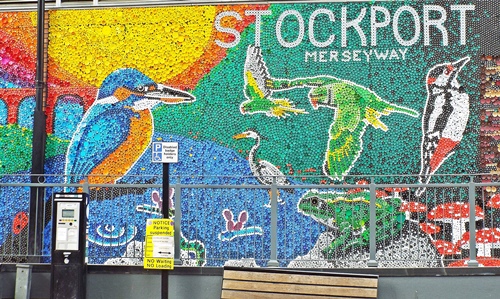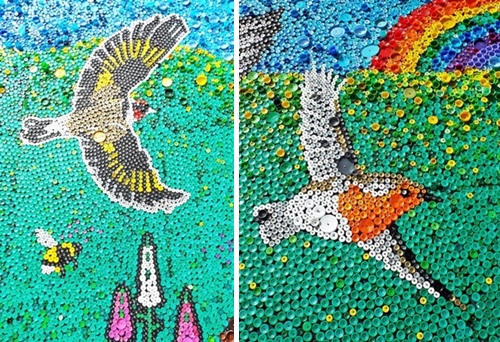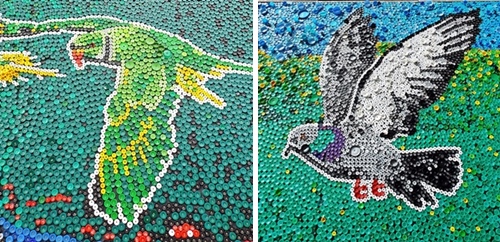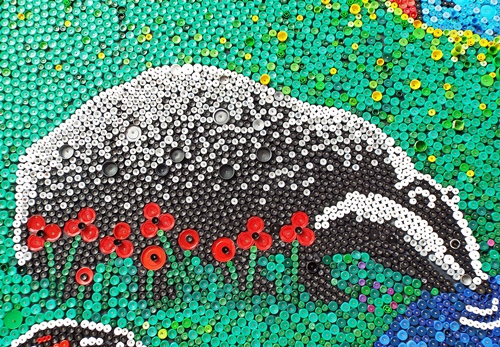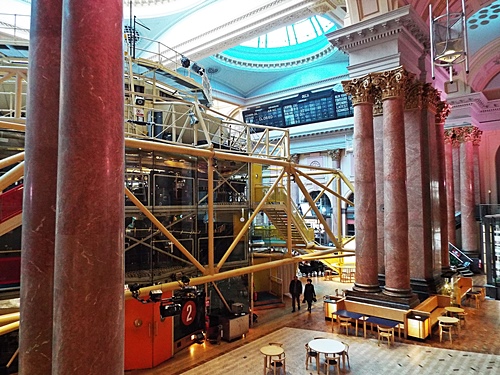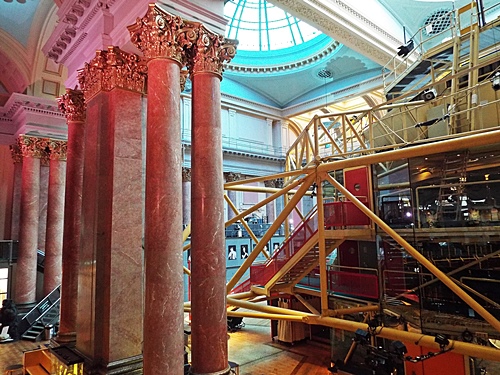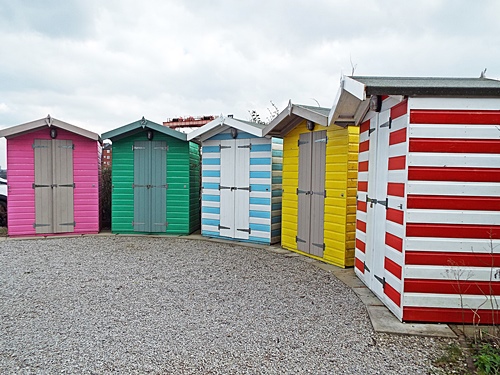Month: March 2024
Manchester’s Royal Exchange – when cotton was king and beyond
As part of this month’s mosaic art trail round Manchester city centre one of the artworks is located within the Royal Exchange Theatre just a 7-minute walk from Victoria Station. Although I’ve walked through the next-door Royal Exchange Arcade many times I had never been in the theatre before I went to look for the mosaic and to say I was amazed by what I saw is an understatement, however more of that later.
The present Royal Exchange dates back to the early 1870s and is actually the third Exchange to be built. The original Exchange was built in 1729 by Sir Oswald Mosley, the Lord of the Manor, in what was then known as Market Place; the open-sided ground floor was a place for business folk, merchants and manufacturers to meet on Tuesdays and Thursdays and strike deals, while the upper floor was occupied by the Court Leet, the ancient Court for the Manor of Manchester. Unfortunately the town’s industry hadn’t yet reached the levels that required a dedicated business exchange and over the years parts of the building became used for different purposes, with raucous cock fights being a common occurrence. With the ever-present pungent aroma of the butchers’ stalls in the nearby Shambles and the building itself gradually falling into disrepair it was eventually demolished in 1792.

Ironically that was the time when Manchester’s involvement in the cotton trade was beginning to gather momentum and the need for a dedicated business meeting place soon made itself clear. In 1804 work began on a second Manchester Exchange, designed by architect Thomas Harrison with the £20,000 cost being paid for in advance by 400 members who bought £50 shares and paid £30 each to buy the site. Situated on part of the current site the new building opened in 1809 and was a very lavish affair accessible only to members paying a subscription of two guineas per year. New facilities included a well-stocked newsroom, a Post Office, a bar, and a dining hall which could house an orchestra and double as a ballroom, while space was rented out to retailers including a tailor, a hatter, and a rare books and paintings dealer.
As the cotton industry continued to expand so did membership of the Exchange, leading to demands for a much larger building. Between 1839 and 1841 the Post Office and some of the interior walls were removed and the main room was extended but there still wasn’t enough space to accommodate the ever-increasing number of members so the Exchange Committee planned a totally new extension. This was completed in 1849 and effectively doubled the size of the building; when Queen Victoria, Prince Albert and other members of the Royal Family made an official visit to Manchester in October 1851 the expanded Exchange was deemed suitable to host the large-scale civic reception. The following month the Home Secretary informed Manchester’s Mayor that Victoria had given the building her seal of approval and from then on it should be known as the Royal Exchange; a large sculpted coat of arms was added to the exterior of the building in honour of its updated status and two years later Manchester itself received official city status as the population had passed 300,000.

As Manchester’s cotton industry continued to flourish it was decided to expand the Exchange building yet again. Though various possibilities were discussed, including relocation, it was eventually decided to demolish the existing building and replace it with a larger Royal Exchange built on the same site. Designed by Mills & Murgatroyd, construction of the third Exchange began in 1867 and was done in two stages. Phase 1 opened in 1871 and by the time phase 2 was completed and opened in 1874 membership had risen to 6,600. The new building was ten times the size of the original Exchange and had a Great Hall measuring 206ft by 96ft with three glass domes 120ft above its centre. It was often referred to as ‘the biggest room in the world’ and though this was more of an honorary title than an actual fact it could still lay claim to being the largest commercial room in existence.


With the cotton industry continuing to grow and prosper membership of the Royal Exchange had reached over 10,000 by the early 1900s and it became necessary to expand the building once more, with Bolton architects Bradshaw, Gass and Hope appointed to draw up plans and oversee the work which was started in 1914. The grand portico at the front of the building was taken down and the main entrance moved to the rear, while a new second hall, a mirror of the original, doubled the size of the trading area.

The largest single commercial room in the world now covered 1.7 acres with the building itself containing 250 offices, 38 shops, 6 restaurants and a post office; the scale of the extension was so large that today’s 90-seat studio theatre fits neatly into what were then the gentlemens’ toilets. Due to delays and disruptions caused by the outbreak of World War 1 it took seven years to complete the work, with the newly enlarged Exchange being reopened in 1921 by King George V and Queen Mary in front of a 15,000-strong audience gathered in the extended hall.
By the late 1920s the Royal Exchange controlled more than 80% of the world’s trade in finished cotton and membership had passed 11,000. All good things come to an end sometime though and the bubble of a hugely successful cotton industry finally burst in the 1930s. Decades of almost unbroken growth and healthy profits were replaced by a steady decline in trade as Manchester gradually lost out to countries with easier access to raw materials and cheaper labour costs. The Government’s attempts to protect the industry came too late and membership of the Royal Exchange inevitably declined.
In December 1940 the Exchange lost its claim to be the biggest trading room in the world when the 1874 half of the building was seriously damaged after taking a direct hit from an incendiary bomb during the World War 2 ‘Manchester Blitz’. It was rebuilt between 1947 and 1953 but with a smaller trading hall and a much simpler exterior, while the top stages of the clock tower, which had also been destroyed, were replaced in a simpler form. The building was finally reopened by Princess Margaret in November 1953.

By 1960 membership of the Exchange had fallen to 2,062 and the City Council gave permission to reduce the size of the trading hall by half and build two floors of offices in the unused space. Eight years later modern technological developments had transformed how industry deals were conducted and the Exchange seemed to serve very little purpose; just 660 members remained and the Master of the Exchange announced its impending closure. Trading, such as it was, continued right up to the end of the year and on December 31st 1968 the Royal Exchange trading hall closed its doors for the final time.

The evolution of today’s Royal Exchange Theatre began in 1973 when the City Council invited the 69 Theatre Company, based at Manchester University Theatre, to construct a temporary performance space within the Exchange’s Great Hall which had been vacant since its closure five years earlier. Built from recycled materials including scaffolding, old hoardings and discarded theatre seats the roof and exterior were draped in fabric, which led to it being nicknamed ‘The Tent’. Seating 430 around a circular stage it was intended to fulfill its purpose for only three weeks but it proved to be such a success that it stayed up for ten months.
The Tent was eventually dismantled in February 1974 and in October that year the building became Grade ll listed, but The Tent had paved the way for something much bigger, better and permanent. Finances were raised via fundraising events and gala performances in other venues, substantial grants came from the Arts Council and Manchester City Council plus donations came from local businesses and private individuals, including many prominent actors, and from late 1974 the 69 Theatre Company staged productions in the nave of Manchester Cathedral. On April 14th 1975 work on the Royal Exchange Theatre began and by early 1976 the 69 Theatre Company had been officially renamed the Royal Exchange Theatre Company.
Designed by artistic director Richard Negri, one of the theatre company’s founding members, the futuristic seven-sided tubular steel and glass module cost £1.2 million to create. Encircling a central open stage 450 seats rise from the Exchange floor with two galleries above, each with 150 seats set in two rows. During construction it was discovered that the floor of the Exchange would be unable to take the theatre’s 150-ton weight so the upper galleries were suspended from the four square pillars which support the large central dome, with only the stage level seating connecting the structure to the floor. The finished theatre was officially opened by Laurence Olivier on Wednesday September 15th 1976, launching with a production of Sheridan’s ‘The Rivals’ with a cast which included Tom Courtenay and Patricia Routledge, and over the years since then the Royal Exchange has established itself as one of the country’s most significant theatre companies with many well known actors appearing there.
In June 1996, just over a week into what was intended to be a month-long production of Stanley Houghton’s ‘Hindle Wakes’, the Royal Exchange suffered extensive damage when the IRA truck bomb exploded just fifty yards away. Fortunately the theatre module itself was unaffected as it was set on lorry shock absorbers as part of the acoustic system, but it took two years and a National Lottery grant of £32 million to repair and refurbish the building. The theatre’s central dome, which had moved several inches in the blast, was stabilized and re-glazed, every pane of glass was replaced, all the internal walls were replastered and repainted and a second but smaller performance space, The Studio, was created with an automated 7-line flying system and its own foyer and bar. A restaurant, bar, and rooms for corporate hospitality were created round the perimeter of a lighter and brighter main hall and state-of-the-art audio and lighting equipment was installed. The refurbished theatre was re-opened on November 20th 1998 by Prince Edward, with the opening production being ‘Hindle Wakes’, the play which was so dramatically cut short the day the bomb exploded.
Today the Exchange’s Great Hall is a visitor destination in itself, open six days a week from 9am to 5pm unless there’s a performance taking place. With small themed exhibitions and displays, comfy settees in quiet corners, a hideout on the balcony and a public lounge vistors are welcome to pop in any time for a leisurely coffee, to grab some lunch or just sit and read a book or work on a laptop.



When I went in the theatre earlier this month I was quite unprepared for what hit me – through a combination of contrasting paint colours and strategic lighting this place had so much ‘wow’ factor that I almost forgot to photograph the mosaic I’d gone to find. Needless to say I spent quite some time wandering round, soaking up the atmosphere and photographing everything which could possibly be photographed.
The production at the time, ‘Shed : Exploded View’, was on the last day of its run and I could have booked a seat for the later performance but having previously read the synopsis I wouldn’t want to watch it, however I did get a photo of the shed which apparently got dismantled at the start of each performance.

Up on the balcony I found the lounge and the hideout and right at the end I got a good view of the original trading boards set high up on the wall, showing the closing figures on the final day back in 1968 when all cotton trading at the Exchange ended permanently.
The history of this building is fascinating; the Great Hall is amazing, the ‘new’ works well with the ‘old’ and the colours are stunning – if I hadn’t been looking for a mosaic artwork I probably would never have gone in there but I’m so glad I did.
Preston Marina and a riverside walk
Just over a week ago a morning full of blue sky and sunshine prompted me to ditch the housework and drive the 20-miles to Preston marina and old dock. It’s a place I hadn’t visited for several years and there was a part of the area which I was keen to explore.
The history of Preston Dock dates back to 1884 and though I’ve written about it previously I think it’s interesting enough to repeat it for anyone who wasn’t following my blog back then. Although Preston itself is 16 miles from the coast boats were travelling along the River Ribble to and from the city for hundreds of years. In 1825 the New Quays, later named Victoria Quays, were constructed but with the river being tidal boats could only get in and out at certain times and as ships gradually got larger the waterway became a problem.
The solution lay in the building of a large dock basin with a set of locks to control the water level and construction began in 1884. The river was moved away from its original line and four million cubic yards of soil were dug out of a 40-acre site, creating a dock basin 40ft deep, 3,000ft long and 600ft wide – it took a month to fill it before it could be used for the first time and it was the largest single dock in Europe. Such a large project required a large investment however and the initial £500,000 budget was soon exceeded, with the council needing a further equivalent amount resulting in a mortgage which would take over sixty years to pay off.
The dock was officially opened in 1892 by Queen Victoria’s son Prince Albert Edward (the future King Edward Vll) and was named after him, and the SS Lady Louise, chartered by E H Booth & Company (now better known as Booth’s supermarkets) was the first ship to unload its freight there. Only four ships used the dock in its first year but by the turn of the century that number had risen to 170 and was still increasing; the main imports were timber, china clay, coal, oil, petrol, bananas, wheat and Irish cattle. In 1936 new Art Deco style dock offices opened nearby and two years later a dock railway was added to the site.
During WW2 the dock was taken over by the military and used as a marshalling post, then in 1948 the first ever roll on/roll off ferry service was introduced, sailing to and from Larne in Northern Ireland using the SS Cedric, a former tank landing ship. Trade increased throughout the 1950s and the port was so successful that the original mortgage repayments were no longer charged on Preston residents’ rate bills. By the 1960s the port was at its peak and holding the record for handling the largest amount of container and ferry traffic, but by the early 1970s it was starting to flounder as nearly half of the income generated was being spent on dredging the river to allow access for increasingly bigger ships. Larger ships meant that fewer could use the port and trade began to fall away; the city lost many of its imports and the Larne ferry stopped running as it was unable to compete with ports such as Liverpool which could offer a faster turn-around time. Preston’s port became uneconomical and in 1979 the decision was made to redevelop the site; the dock finally closed in 1981 with a great number of job losses and a major redevelopment of the area started in 1982.
After dealing with the polluted water and land a new road infrastructure was put in place and over the next several years a huge amount of work was done. The lock gates were repositioned to stop flooding from storms, a boatyard with chandlery facilities was constructed and the original railway line which ran on the north side of the dock was removed, with a new line being laid on the south side between the river and the dock basin. A swing bridge was installed over the dock entrance for the passage of vehicles, trains, pedestrians and boats, and a new Dock Control Centre was built close to it, although industrial railway traffic eventually ceased in 1995 with the line subsequently being operated for leisure by the Ribble Steam Railway Company.
Many modern homes have been built on the strip of land between the river and the south side of the dock with the old Shed No.3 being converted into Victoria Mansions apartments, while the north side of the basin features many retail and leisure developments with Homebase, Morrison’s, Halford’s and Pets At Home now being just a few of the stores along that side. A pleasant promenade runs round three sides of the dock with the swing bridge making the fourth side, and the west end of the basin itself is home to a 350-berth marina which opened in 1987.
My walk started from the free car park overlooking the water on the north side of the dock basin and just across the road was the lighthouse situated outside the Morrison’s store. There seems to be very little information about this, with some sources saying it was built many years ago to guide ships into the dock and others saying it was only built in 1986 during the dock regeneration and the building of the supermarket, but regardless of which version is true it’s an attractive structure and worth a photo or two. Passing Halford’s, Pets At Home and the Ribble Pilot, a modern pub/restaurant established in 1992, the promenade took me round the end of the dock basin and onto the residential south side.

A distance along I came to the sign pointing between two apartment blocks to the Riverside Walk and through a small estate of modern houses with open plan gardens I crossed the access road and a level crossing over the railway line, which brought me down a grass bank and onto a wide tarmac path running between there and the river. The path forms part of the 21-mile circular Preston Guild Wheel walking/cycling route, eventually turning away from the river and crossing the west end of the dock basin via the swing bridge; I’d been that way a few years previously but this time I headed into the unknown along a rough tree lined track which continued to follow the line of the river.
It wasn’t long before I left the trees behind and the path took me onto a pleasant area of open land with a couple of benches to sit and take in the views over the river; this was the Bullnose, part of the entrance to the outer dock basin and now a popular place for fishing. Behind the huge lock gates a narrow pedestrian bridge took me across to the far side of the basin and another section of the Guild Wheel running past the back fences of a few modern houses, and set back on a corner was a huge black painted ‘thing’ which had no information but was presumably something left over from the docks and put there as a feature.



Passing the Ribble Steam Railway Museum and a large warehouse, both of which I could see through the trees, the path took a right turn onto a road but there was a gap in the nearby railings and a rabbit track led me down to the riverside. It didn’t go very far though and as I didn’t want to risk falling into the water I just took a couple of shots looking back towards the Bullnose then retraced my steps. On the corner where the path joined the road was a large and very odd looking red brick building – there was nothing anywhere to tell me what it was but with its close proximity to the railway museum it could possibly be an old engine shed.
Back over on the Bullnose a minor road led from there past the outer basin and a long row of modern houses then across on the far side and not far from the swing bridge was the boatyard. Across the main road a pleasant green and the Dock Control Centre overlooked the entrance to the main basin and on the corner was the huge 100 ton crane built in 1958 to remove the lock gates from the water for refurbishment on dry land. Made of Greenheart timber and Iroko planking the gates weigh 98 tons each – large flotation devices were fixed to each side, enabling them to be floated out of their fittings and brought to the crane for lifting. The crane is still used today but only for lifting and lowering larger boats.
Across the swing bridge and at the start of the promenade on the north side of the basin was the Beach Hut coffee bar and tucked in a nearby corner was something I didn’t expect to see – a row of five brightly painted but very small beach huts. They hadn’t been there on my previous visit to the area and with no indication as to their purpose I assumed they were connected to the nearby Dragon Boat Racing Club. Continuing along the promenade I passed several modern two-storey blocks of office suites and the marina then finally I was back at the car park where I left the van.
It was unfortunate that after the lovely sunny start, where at one point during the walk I was able to shed my jacket for the first time this year, the sky clouded over and the afternoon had turned quite dull. It had been a very enjoyable walk though and it had been good to discover somewhere new – and with Preston being not too far from home maybe it won’t be too long before I do it all again.
The day from hell
I suppose there are many people who have the odd day here and there when everything seems to go wrong and they wish they had never got out of bed, well that was me yesterday. Happy Mother’s Day? – well no, it wasn’t.
After not being able to find the John Wayne mosaic at HOME arts venue on the art trail in Manchester a week ago I found out from the trail’s organiser that it would be reinstated in a different part of the building so yesterday I went to see it, with the idea of visiting somewhere else in the city beforehand, however right from the start things didn’t go according to plan. The train from my nearest station should have been just after mid day but by 12.30 it hadn’t arrived; now this station isn’t exactly in the middle of nowhere, it’s in the centre of a large housing estate, but there’s absolutely no train information anywhere, so I decided to get a bus from a nearby stop and go to the main interchange in town.
According to the bus timetable I would only have a couple of minutes to wait, however the main road seemed to be much busier than normal with a long queue of traffic and the bus was almost ten minutes late – I found out later that the delay had been caused by a two-car crash further up the road. By the time I got to the main station I’d missed a Manchester train by about thirty seconds; looking at the information boards it seemed that many services were cancelled (according to various tannoy announcements ”due to unscheduled timetable changes”) and I had half an hour to wait for the next train.
I finally arrived in Manchester at 1.45pm, only to find that the first of the two places I was visiting was closed, so I hopped on a tram which would take me to the station nearest to HOME where I could see the John Wayne mosaic. There was an art exhibition in part of the ground floor so once I’d photographed the mosaic I had a wander round there, and though I liked some of the artworks on display, especially the cats, many others left me less than impressed – they were pointless, stupid, and some of them could have been created by a five-year old child in just a few minutes.


After wandering round the exhibition I decided to go to the cafe/bar and it’s a good thing I wasn’t dying of thirst and starvation or I would have been in a heap on the floor by the time I got served. Now when it comes to food I’m not that hard to please but I dislike spicy stuff and everything on the menu included peppers and other spicy things so I opted for coffee and cake; the slice of rainbow cake was good when I finally sat down but the coffee wasn’t exactly hot. It was raining when I came out of HOME so deciding to cut my losses and come home rather than go anywhere else I got the tram back to Victoria station but getting back here proved to be almost impossible.
The 3.40pm train going to my nearest station was cancelled, as was the next one half an hour later and the one after that, however a guy at the information stand told me I could get the Southport train to my main station. It meant waiting an hour so I went for a wander round the nearest shops to kill some time, however when I finally went for the Southport train I found it didn’t come through my home town at all – the guy at the stand had given me the wrong info. So I asked another guy and was told my only option was to get a train from Piccadilly station; it was another tram ride between stations and a good walk from the Piccadilly tram stop via various moving walkways to the main concourse, and by the time I’d found the right platform I’d missed the next train by less than a minute!
By this time I’d just about lost the will to live but as throwing myself in front of the next moving object wasn’t an option I went to ask a sensible looking young lady at the barrier and was assured that I could get the next Windermere train which would stop at my main station. Another 50-minute wait and I was finally on a train going in the right direction, however when I got to my main station my journey wasn’t over. I still had to get from there to the car park at my local station where I’d left the van – and the next bus wasn’t for another half hour. By this time though I’d had enough of waiting around so I phoned for a taxi which dropped me off at the station car park and finally, at almost 7pm, I walked through my own front door.
I don’t know what it’s like in other areas of the country for train drivers going on strike – it’s been happening here on and off for several months but normally I don’t have any problems getting to and from Manchester on Sundays. Yesterday though was just a nightmare, even the young lady at the Piccadilly station barrier had said it was really bad. I won’t be going to the city for a while now however, though I think the next time I venture that way it will be on any day except Sunday!
A Manchester mosaic mission
For more than 200 years Manchester has had a sizeable Irish community and today it’s estimated that around 35% of the city’s population has some Irish ancestry. The annual Manchester Irish Festival, the biggest such event in Europe, has been a feature of the city for over thirty years and this year’s festival, running from Friday March 8th to Sunday March 17th, will see 200 events take place across 80 locations within the city. To coincide with the festival a series of seventeen mosaics, created by mosaic artist Mark Kennedy and depicting several well known Irish personalities, have appeared in various venues as part of a month-long art trail which started on March 1st, and yesterday I went on a mission to track them all down.
Although I’d downloaded and printed out a map of the locations they weren’t listed in any sensible order so to avoid any back-tracking I plotted my own route around the city starting from Victoria Station. The first two mosaics, singer Sinead O’Connor (1966-2023) and ‘The Pogues’ Shane MacGowan (1957-2023) were just a very short walk from the station and I found them in the entrance at New Century Hall.
In the cafe at the National Football Museum I found George Best although the artwork was in a cabinet and it was difficult to get a decent photo without a lot of light reflection, then along the road Brendan Behan, poet, playwright, novelist and activist (1923-1964) was located in the Royal Exchange Theatre.
In Gallery One on the first floor of the People’s History Museum was the Countess Markievicz mosaic which was one I’d been particularly interested in seeing as a few years ago I saw a statue of this particular lady in Dublin. It’s a statue which is unique among all those in Dublin as it also includes the subject’s dog, a Cocker Spaniel named Poppet, and there’s an interesting little story connected to it. It’s one which I related back in 2019 after a holiday in Ireland but I think it’s worth repeating for anyone who wasn’t following my blog back then.
Constance Markievicz (1868-1927) was an Irish politician, revolutionary, nationalist and suffragist, playing quite a part in Ireland’s fight for independence. Just before the 1916 Easter Rising she had the task of making a flag for rebel headquarters but with the shops being closed for Easter she had to improvise so used a green bedspread stretched out on her drawing room floor. While she was trying to cut out the shape Poppet kept pulling at the material until he tore a piece out of the side but undeterred the Countess carried on, painting the words ‘Irish Republic’ in gold. The flag was then smuggled into the Irish Citizen Army headquarters in Dublin and from there taken to the GPO to fly from the roof during the rebellion.
The flag is now on display at Dublin’s National Museum, a revered symbol of the Republic’s foundation although a rather damaged one. It’s believed though that the damage wasn’t all Poppet’s work; half the ‘c’ in ‘Republic’ is missing, presumably shot away during the Rising, but if the original story is true then what was finished by the guns was actually started by an unruly spaniel.
Back to the mosaic hunt and in a window at the Science & Industry Museum was the John F Kennedy mosaic though unfortunately it was situated right where two opaque bands are incorporated across the glass pane. Back in November 1963 Manchester-based Granada Television beat the rest of the country to be the first in Britain to announce that President Kennedy, America’s first Irish-Catholic president, had been assassinated. Thanks to a tip-off, news anchorman Mike Scott told northern viewers of the tragic event in Dallas half an hour before news reached the rest of the country.
A few minutes walk from the museum took me to 53Two theatre bar and the mosaic of Irish dramatist, poet, writer and theatre director Samuel Beckett (1906-1989) then another few minutes took me to HOME theatre, though I was destined to be disappointed with this location. ”The Quiet Man” mosaic was said to be situated in the entrance but I couldn’t find it anywhere and the two staff members I asked hadn’t a clue what I was talking about, however a nice young lady in the box office knew. Apparently it was a mosaic of John Wayne in the film of that name which was shot on location in Ireland but it had been removed not long after being put on display because someone (she didn’t say who) had taken offence and complained about it, however I’ve found a picture of it on the trail organiser’s website.





